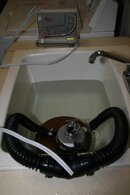reefrat
Contributor
Whatever you put over an exhaust outlet you need to be sure that it does not impede the flow of bubbles! I am not well versed in these matters but I have read that modern second stage designs have small wide open exhaust tees to vent exhaust bubbles quickly and efficiently so that there is no back pressure on exhalation- apparently the performance of many balanced downstream valves is now so good now that resistance to exhalation is a limiting factor in overall work of breathing (WOB).I wonder if the air conditioner filter mesh would be fine enough to diffuse the flow? Home centers and appliance stores have that by the package.
Pete
Once again, I don't want to upset anyone who wants to keep this forum strictly pre-80's but I have to mention here (as an example) that I tried a new Aqualung Titan reg recently and was pleasantly surprised how quiet the exhaust bubbles were due to to the baffled design of the exhaust outlets.
When I say "stealth" I am envisioning a scuba unit that is quieter in every respect. Perhaps operates at a lower IP and uses a larger diameter low pressure seat to reduce the velocity of gas release on inhalation and therefore sound more like inhaling on a snorkel than a scuba demand valve. The exhaust valve would designed to form bubbles with minimal noise and divert them away from the face/ ears toward the rear of the divers head. I have done a little research on what actually causes the noise when bubbles are formed is an interesting and surprisingly complex, as a example:
"Gas bubbles, when entrained in water or other liquid, can generate high sound pressures in the liquid. Significant sound pressures are associated only with volume pulsations of the bubble, whereas oscillations in the shape of the bubble do not result in appreciable sound. Calculations have been made of the sound pressures resulting from excitation of volume pulsations by the following mechanisms: by bubble formation, coalescence, or division; by the motion of a free stream of liquid containing entrained bubbles past an obstacle; and by the flow of liquid containing entrained bubbles through a pipe past a constriction. The calculation of the sound pressure generated by bubble formation has been verified by measurements with bubbles formed at a nozzle."
© 1956 Acoustical Society of America
I am sure there has been enough research in the military, as well as industrial sectors, to design an efficient exhaust valve that is much quieter than conventional types.
A scuba unit that works like a "normal" one, but is relatively quiet to dive would probably generate a lot of interest!
Cheers




